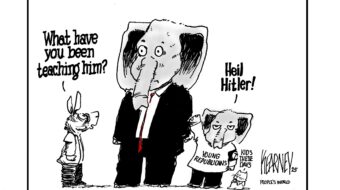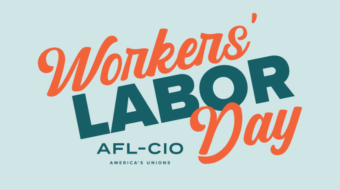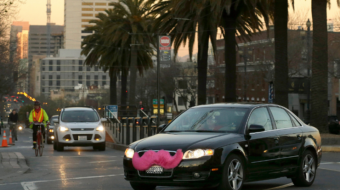ST. PAUL, Minn. – Right-wing Minnesota politicians, taking part in the national war on workers, have turned towards putting two controversial state constitutional amendments on the Minnesota ballot this fall; organized labor has already begun to battle both.
One of the far-reaching proposals would write so-called “voter ID” laws into the state’s basic charter, making it harder for minorities, the poor, college students, the elderly, those without drivers’ licenses, and others to register and vote.
The other scheme would insert a so-called “right to work” law into the constitution, banning unions from collecting dues or equivalent fees from non-members covered by union contracts.
Right to work sounds innocent enough in name, but in reality it is yet another corporate attack on middle class families, union contracts, and workplace safety, unionists point out.
“These laws are nothing more than another attack on the middle class,” Bobby Kasper, president of the St. Paul Regional Labor Federation, wrote in the St. Paul Union Advocate.
“We cannot sit back,” he declared. “We cannot wait and see whether state lawmakers, looking to repay the corporations and wealthy donors who put them in office, will put a right to work constitutional amendment on the ballot next fall. We need to get the word out now: right to work is wrong for Minnesota.
“Contrary to its name, right to work doesn’t guarantee workers any rights. Instead, it allows some workers to choose to pay nothing – and still enjoy the rights and protections of a union contract others are paying dues to maintain. That makes it harder for unions to bargain for contracts that improve workers’ wages, benefits, and working conditions.
“In fact, workers in right to work states earn, on average, $6,150 less than workers in Minnesota. What’s more, Minnesota has fewer workplace injuries, better public schools, and a higher percentage of people with health insurance coverage than states with right to work laws on the books.
“So who thinks right to work is a good idea? Corporations and CEOs do – and so do the politicians they helped put into office. Is it any surprise that the same politicians who bailed out Wall Street are now going after struggling middle class workers with right to work?
“We need you to tell your friends, family, and co-workers how bad right to work really is,” Kasper concluded.
The other idea the right wing is pushing is to strip people of the right to vote – and thus deprive them of a key lever in the fight against corporate domination of politics.
Unmoved by an outpouring of public opposition from seniors, workers, and advocates for the poor, lawmakers in the Minnesota legislature appeared poised last month to push another constitutional amendment onto the November ballot: Voter ID.
The amendment, opposed by the state’s unions, would restrict the right to vote to people able to present photo identification at the polls.
The amendment cleared the Minnesota House, and it was making its way through Senate committees. Gov. Mark Dayton vetoed a similar bill last year, but Minnesota governors cannot veto proposed constitutional amendments.
The voter ID amendment seems harmless enough, but opponents say the requirement, if passed, will suppress voter turnout among populations less likely to possess photo ID – including the elderly, minority groups, and people who don’t drive.
Those opponents include the Minnesota AFL-CIO and the Minnesota chapter of AARP, which testified against the bill at a Senate committee hearing in February.
“We are very concerned that a constitutional amendment on Voter ID, if passed, would hamper the ability of many older Minnesotans to vote,” AARP Minnesota said in a statement. “We believe that requiring a Voter ID will create unnecessary and costly burdens for many older voters.”
New restrictions might be justified, opponents said, if voter fraud were a problem in Minnesota. But according to non-partisan audits of the state’s elections, voter fraud is virtually non-existent in Minnesota.
That leads some foes to believe the problem Republicans are trying to solve with the voter ID amendment is that too many seniors and low-income Minnesotans are voting – and voting for Democratic-Farmer-Labor candidates.
That’s the opinion of Northfield resident John Frasz, who joined a rally against voter suppression at the state capitol on Feb. 8. Republicans, he said, “aren’t fooling anybody with this amendment. It’s about keeping Democrats from voting. And it’s the most un-American thing I’ve ever seen in Minnesota.”
The Feb. 8 rally drew more than 100 opponents of voter ID to the state capitol. Action included a bit of street theater, as opponents of voter ID covered their mouths with dollar bills, symbolizing the corporate interests pushing voter ID and their attempt to silence poor and elderly voters with campaign cash.
The prior Feb. 1 hearing had to be called off before everyone in the crowd who wanted to testify against the amendment could do so. That included Ilo Madden, a 73-year-old St. Louis Park resident who is oxygen-dependent and on a respirator.
A regular absentee voter, Madden said, “One of the reasons we have absentee voting is so people like me, who have severe issues with mobility, can participate in our electoral process. Requiring me to present a photo ID in person before voting, would make it incredibly hard, if not impossible, for me to vote absentee.”








